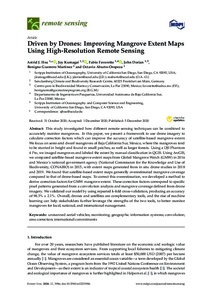| dc.contributor.author | Hsu, Astrid | |
| dc.contributor.author | Kumagai, Joy | |
| dc.contributor.author | Favoretto, Fabio | |
| dc.contributor.author | Dorian, John | |
| dc.contributor.author | Guerrero Martinez, Benigno | |
| dc.contributor.author | Aburto-Oropeza, Octavio | |
| dc.date.accessioned | 2020-12-23T14:34:19Z | |
| dc.date.available | 2020-12-23T14:34:19Z | |
| dc.date.issued | 2020 | |
| dc.identifier.citation | Hsu, A.J.; Kumagai, J.; Favoretto, F.; Dorian, J.; Guerrero Martinez, B.; Aburto-Oropeza, O. (2020) Driven by Drones: Improving Mangrove Extent Maps Using High-Resolution. Remote Sensing,12:3986, 18pp DOI. http://dx.doi.org/10.3390/rs12233986 | en_US |
| dc.identifier.uri | http://hdl.handle.net/11329/1468 | |
| dc.identifier.uri | http://dx.doi.org/10.25607/OBP-970 | |
| dc.description.abstract | This study investigated how different remote sensing techniques can be combined to accurately monitor mangroves. In this paper, we present a framework to use drone imagery to calculate correction factors which can improve the accuracy of satellite-based mangrove extent. We focus on semi-arid dwarf mangroves of Baja California Sur, Mexico, where the mangroves tend to be stunted in height and found in small patches, as well as larger forests. Using a DJI Phantom 4 Pro, we imaged mangroves and labeled the extent by manual classification in QGIS. Using ArcGIS, we compared satellite-based mangrove extent maps from Global Mangrove Watch (GMW) in 2016 and Mexico’s national government agency (National Commission for the Knowledge and Use of Biodiversity, CONABIO) in 2015, with extent maps generated from in situ drone studies in 2018 and 2019. We found that satellite-based extent maps generally overestimated mangrove coverage compared to that of drone-based maps. To correct this overestimation, we developed a method to derive correction factors for GMW mangrove extent. These correction factors correspond to specific pixel patterns generated from a convolution analysis and mangrove coverage defined from drone imagery. We validated our model by using repeated k-fold cross-validation, producing an accuracy of 98.3% ± 2.1%. Overall, drones and satellites are complementary tools, and the rise of machine learning can help stakeholders further leverage the strengths of the two tools, to better monitor mangroves for local, national, and international management. | en_US |
| dc.language.iso | en | en_US |
| dc.rights | Attribution 4.0 International | * |
| dc.rights.uri | http://creativecommons.org/licenses/by/4.0/ | * |
| dc.subject.other | Drone | en_US |
| dc.subject.other | UAV | en_US |
| dc.subject.other | Unmanned aerial vehicles | en_US |
| dc.subject.other | Mangrove monitoring | en_US |
| dc.subject.other | Geographic Information Systems (GIS) | en_US |
| dc.subject.other | Convolution | en_US |
| dc.subject.other | Area correction | en_US |
| dc.subject.other | International committments | en_US |
| dc.title | Driven by Drones: Improving Mangrove Extent Maps Using High-Resolution Remote Sensing. | en_US |
| dc.type | Journal Contribution | en_US |
| dc.description.notes | Drone imaging manual: held: http://dx.doi.org/10.25607/OBP-969 | |
| dc.description.refereed | Refereed | en_US |
| dc.format.pagerange | 18pp. | en_US |
| dc.identifier.doi | 10.3390/rs12233986 | |
| dc.subject.parameterDiscipline | Parameter Discipline::Environment | en_US |
| dc.subject.dmProcesses | Data Management Practices::Data acquisition | en_US |
| dc.subject.dmProcesses | Data Management Practices::Data analysis | en_US |
| dc.bibliographicCitation.title | Remote Sensing | en_US |
| dc.bibliographicCitation.volume | 12 | en_US |
| dc.bibliographicCitation.issue | Article 3986 | en_US |
| dc.description.sdg | 14.5 | en_US |
| dc.description.eov | Mangrove cover and composition | en_US |
| dc.description.maturitylevel | TRL 9 Actual system "mission proven" through successful mission operations (ground or space) | en_US |
| dc.description.bptype | Manual (incl. handbook, guide, cookbook etc) | en_US |
| obps.contact.contactname | Astrid Hsu | |
| obps.contact.contactemail | ajhsu@ucsd.edu | |
| obps.contact.contactorcid | 0000-0003-4646-5893 | |
| obps.resourceurl.publisher | https://doi.org/10.3390/rs12233986 | en_US |
 Repository of community practices in Ocean Research, Applications and Data/Information Management
Repository of community practices in Ocean Research, Applications and Data/Information Management

